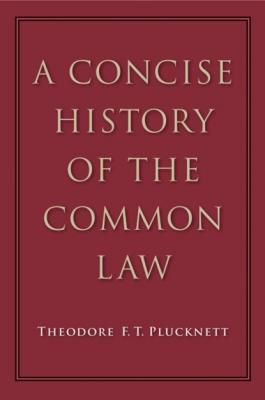A Concise History of the Common Law. Theodore F. T. Plucknett
Читать онлайн.| Название | A Concise History of the Common Law |
|---|---|
| Автор произведения | Theodore F. T. Plucknett |
| Жанр | Юриспруденция, право |
| Серия | |
| Издательство | Юриспруденция, право |
| Год выпуска | 0 |
| isbn | 9781614872474 |
The Ordeals
6. The jury as a new mode of trial
Evolution of the Petty Jury
An Example of the New Criminal Procedure
The Review of Verdicts
The Punishment of Obstinate Jurors
Constitutional Position of the Jury
It is in this complicated interplay of royal and local institutions that the origins of the jury are to be sought; so we can now appropriately turn from the study of the vill and the hundred to the growth of the system of presentment which was so prominent a part of their constitution, and to the later transformation of that system into a method of trial as well as accusation. At the same time, the county’s loss of effective jurisdiction over pleas of land was intimately connected with the rise of the royal writ, and this will be almost synonymous with the use of an assize or a jury of twelve. The criminal jury, therefore, can be treated here because it grew out of the natural expression of the vill and the hundred; but the civil jury in the old real actions was based (as we shall see) upon a somewhat different, though related, idea, which only came to an end with the abolition of real actions. The modern civil jury, it must be remembered, is descended from the old criminal jury through the action of trespass, which was at first partly criminal and later entirely civil in its character.
The discussion may well open with Maitland’s definition of the jury: a jury is a body of neighbours summoned by a public officer to answer questions upon oath.1 It will be seen that there is nothing in this definition which restricts the jury to judicial proceedings; on the contrary, the definition deliberately makes room for the fact that the jury, like so many institutions, was an administrative device which only later became confined to courts of law.
The story is complicated because several different lines of development were being pursued simultaneously, and so it is particularly necessary to have the outlines clearly in mind while the details of this chapter are being studied. The subject will be dealt with in the following order:
1 Early prototypes of the jury;
2 The jury for royal administrative inquiry;
3 The jury for the trial of property cases;
4 The jury for royal criminal inquiry;
5 Ancient modes of trial;
6 The jury as a new mode of trial;
7 Post-mediaeval problems.
1.
Early prototypes of the jury
SUPPOSED ANGLO-SAXON ORIGINS
Ever since the seventeenth century when juries began to express sentiments against the government, there has been a tendency for the jury to become, at least in popular thought, a safeguard of political liberty. It is only natural, therefore, that its history should have been idealised and traced back for patriotic reasons to the supposed golden age of Anglo-Saxon institutions. Various theories have been proposed. According to one the jury is descended from the doomsmen who find the judgment and declare the law and custom in the ancient communal courts. This explanation, however, is by no means satisfactory, for the doomsmen did not find facts (for which there was other machinery available) but declared the law which applied to a state of facts which had already been established. A second suggestion would seek the origin of the jury in the compurgators, of whom we shall speak later; this is open to the objection that the compurgators were summoned by a party and not by a public officer, and could not be compelled to act unless they cared to.
ENGLISH AND SCANDINAVIAN JURIES
A third and more plausible suggestion would see an origin of the jury in a remarkable passage in the laws of King Ethelred promulgated at Wantage, which probably dates from about the year 997.1 It is this:
“And that a gemot be held in every wapontake; and the xii senior thegns go out, and the reeve with them, and swear on the relic that is given them in hand, that they will accuse no innocent man, nor conceal any guilty one....”
It cannot be denied that we have here a remarkable anticipation of the Assize of Clarendon which later was to establish as a regular procedure the presentment of suspected criminals by the hundred. There are one or two other traces in various parts of Scandinavia which may point in the same direction, and by the fourteenth century Sweden certainly had a developed system of presenting juries, and indeed had also created a trial jury (called the Nämnd) both in civil and criminal proceedings.2 The origin and the growth of the nämnd seem to be quite independent of the corresponding institutions in England, and in fact it is not unprecedented to find that two different systems independently come to substantially the same conclusion; but when the historian sees the similarity of the conclusions he must beware of assuming that they are the result of direct contact, unless that contact can be proved by independent evidence. It may well be that this passage in the laws of Ethelred, enacted with a view to the Scandinavian institutions prevailing in that portion of England which had been occupied by the Danes, represents an independent tendency of Scandinavian law. Moreover, before we are entitled to see here an origin of the jury, it will be necessary to establish continuity between the Law of Wantage and the jury as it existed after the Norman Conquest.
